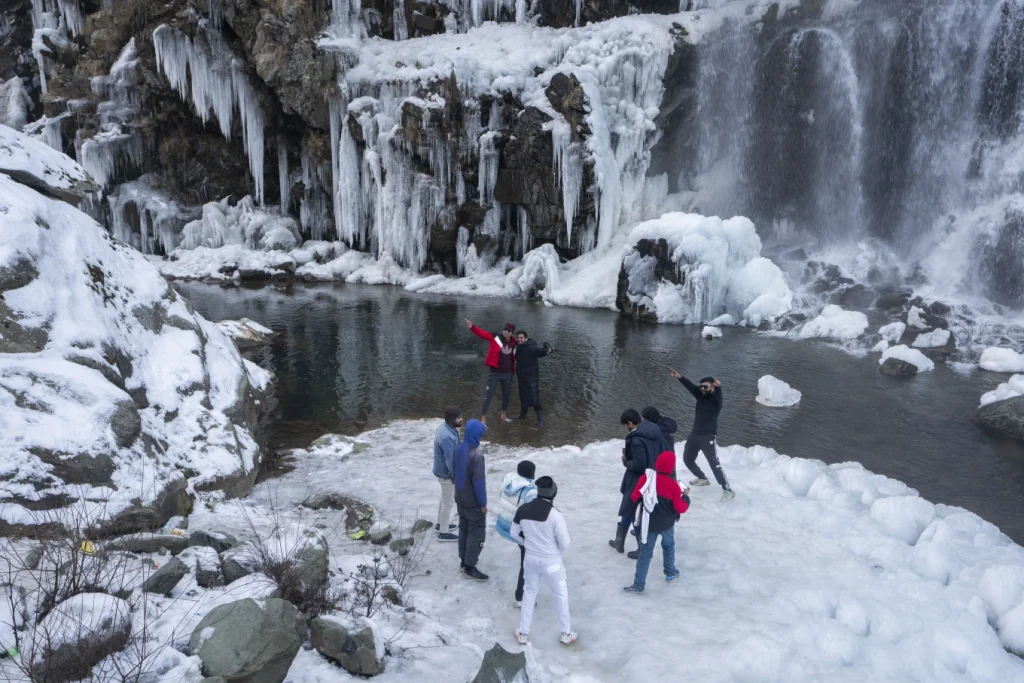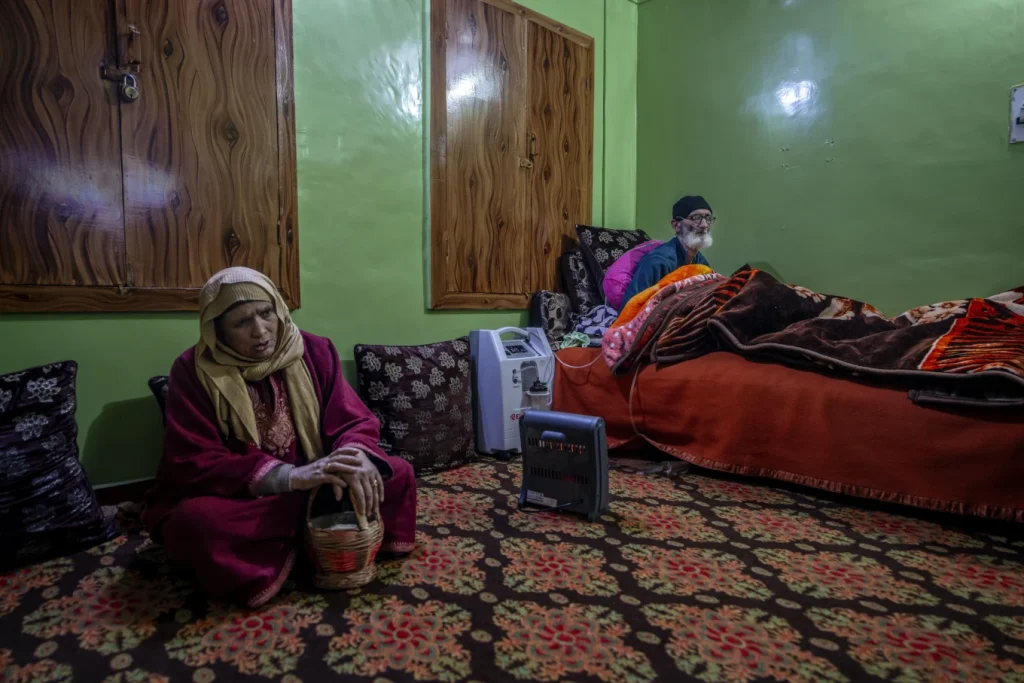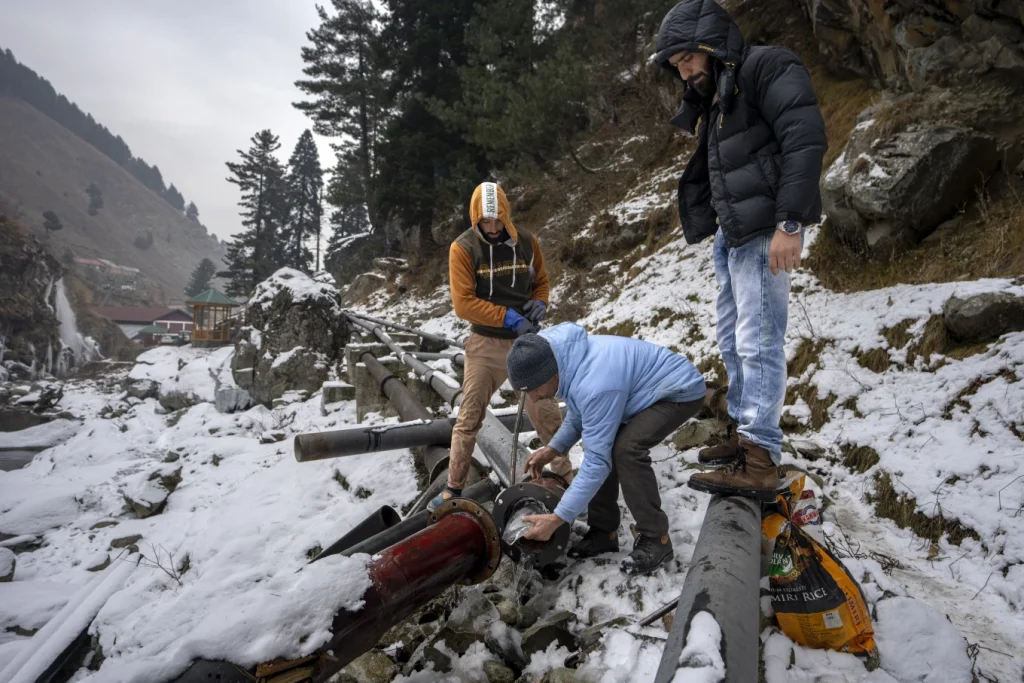Nestled amidst the majestic peaks of the Himalayas, the region of Kashmir undergoes a remarkable transformation during the onset of “Chillai Kalan,” also known as “The Great Winter.”
This period, lasting for approximately 40 days, marks the most severe phase of cold in the disputed territory of Kashmir, commencing in late December and extending into January and early February.
As the skies become overcast and temperatures plummet, the landscape takes on a mesmerizing allure, drawing tourists from far and wide to witness its breathtaking beauty.
The ethereal charm of Kashmir in winter is unparalleled. The once verdant plains are now cloaked in a blanket of snow, the crisp air carrying a sense of tranquility and serenity.
The mountains, adorned with thick layers of snow, stand as silent sentinels, casting a spellbinding aura over the land.
It is a time when nature’s grandeur takes center stage, captivating the hearts and minds of all who are fortunate enough to behold it.
For centuries, Kashmir has been celebrated for its awe-inspiring landscapes, and the winter season only serves to enhance its allure.
As the snow descends upon the region, it transforms into a veritable wonderland, beckoning travelers and adventurers to partake in its offerings.
The region’s hotels and resorts bustle with activity as tourists eagerly engage in activities such as skiing, sledding, and trekking, immersing themselves in the splendor of the Himalayan landscape.
The allure of Kashmir in winter lies not only in its picturesque vistas but also in the unique experiences it offers to those who venture into its midst.
The tranquil beauty of the snow-covered valleys, the glistening frozen lakes, and the majestic snow-capped peaks create an atmosphere of unparalleled enchantment.
It is a time when the land seems to be in a state of suspended animation, as if nature itself has paused to marvel at its own magnificence.
However, beneath the surface of this idyllic winter wonderland lies a complex and tumultuous reality. The region of Kashmir has long been a hotbed of political and territorial conflict, with its status as a disputed territory subject to ongoing debate and contention.
The juxtaposition of the region’s natural splendor with the underlying tensions serves as a poignant reminder of the dichotomous nature of Kashmir, where beauty and strife coexist in an uneasy equilibrium.
The Great Winter in Kashmir is a testament to the resilience of both the land and its people. Despite the challenges posed by the harsh climate and the geopolitical complexities that define the region, the spirit of Kashmir endures, its beauty transcending the limitations imposed upon it.
It serves as a poignant reminder of the enduring power of nature and the indomitable spirit of those who call this land their home.
In conclusion, the onset of “Chillai Kalan” heralds a period of unparalleled beauty and wonder in the region of Kashmir.
As the landscape is transformed into a mesmerizing winter wonderland, tourists flock to the region to partake in its offerings and witness its ethereal charm.
However, beneath the surface lies a complex reality, characterized by geopolitical tensions and territorial disputes.

The Great Winter in Kashmir serves as a poignant reminder of the resilience of both the land and its people, encapsulating the enduring spirit of this remarkable region.
Winter in the region brings with it a myriad of challenges, especially when it comes to the weather conditions that affect daily life in various sectors such as agriculture, transportation, and other livelihoods.
One of the most significant impacts of the winter season is the plummeting temperatures, which can have a profound effect on the daily routines of the locals.
In Kashmir, a disputed region between India and Pakistan that has been plagued by decades of conflict, winter brings subzero temperatures that can be quite harsh and unforgiving.
The locals have devised their own methods of coping with the extreme cold, with the kanger being a major source of heat for many.
The kanger is a pot filled with hot coal embers that is tucked inside the traditional knee-length cloak known as the pheran.
This ingenious method of staying warm has become an integral part of the locals’ daily lives during the winter months, providing them with much-needed warmth and comfort in the face of the biting cold.
The impact of the winter weather is not limited to personal comfort, as it also has far-reaching effects on various aspects of daily life.
For example, the extreme cold can make it difficult for people to carry out their daily work and essential tasks, as they are almost ensnared by the warmth of the kanger and are reluctant to step outside.
This can have a significant impact on agriculture, transportation, and other livelihoods, as people are forced to adapt their routines and practices to accommodate the challenges posed by the winter weather.
Furthermore, the subzero temperatures in Kashmir also coincide with frequent power cuts, adding another layer of difficulty to an already challenging situation.
The region has long struggled with unresolved crises, and the issue of power cuts during the winter months is just one of the many challenges that the locals have to contend with on a regular basis.
The lack of consistent access to electricity can have a detrimental impact on various aspects of life, from household activities to businesses and essential services.
In conclusion, the winter weather in Kashmir presents a host of challenges that affect the daily routines of the locals in significant ways.
From the use of traditional methods such as the kanger to cope with the extreme cold, to the impact on agriculture, transportation, and other livelihoods, the winter season brings with it a set of unique challenges that the people of the region must navigate.
The issue of frequent power cuts only adds to the complexity of the situation, highlighting the need for sustainable solutions to address the long-standing crises that continue to impact the region.
The year 2024 has brought with it a series of challenges for the residents of Kashmir, particularly in the realm of power supply.
The unscheduled power outages, lasting for extended periods of 12 to 16 hours, have not only disrupted patient care for individuals with respiratory illnesses but have also significantly impacted local businesses.
Furthermore, the region’s struggle to harness its hydropower potential has led to a situation where a substantial portion of the power generated locally is diverted to other Indian states, leaving only a meager 13% for Kashmir.
Consequently, the region is compelled to purchase electricity at higher prices from India’s northern grid to meet its energy demands.
The adverse effects of these power outages on healthcare services cannot be overstated. Patients with respiratory illnesses, who depend on continuous access to electricity for medical equipment, have been particularly vulnerable.
The prolonged power cuts have disrupted the functioning of vital medical devices, leading to a compromised level of patient care.
This situation has not only heightened the distress of the affected individuals but has also placed a significant strain on the healthcare infrastructure in the region.
In addition to the healthcare sector, the business community in Kashmir has also borne the brunt of these power outages.

The interruptions in power supply have disrupted the regular operations of businesses, resulting in financial losses and hampering the overall economic stability of the region.
Small and medium-sized enterprises, which form the backbone of the local economy, have faced significant challenges in maintaining their productivity and meeting customer demands.
The impact has been felt across various sectors, including agriculture, manufacturing, and tourism, further exacerbating the economic woes of the region.
The discontent among Kashmiri residents regarding the utilization of the region’s hydropower potential is not unfounded.
The diversion of a substantial portion of locally generated power to other Indian states has left Kashmir grappling with an inadequate supply of electricity.
This has forced the region to rely on purchasing power from India’s northern grid at inflated prices, thereby increasing the financial burden on both the government and the residents.
The disparity between power generation and local consumption has underscored the urgent need for a comprehensive and equitable energy distribution system that prioritizes the needs of the region.
Amidst these challenges, the stillness of winter in Kashmir offers a glimmer of hope for the future. The cold, while bringing about hardships, also serves as a precursor to the vibrancy of spring.
The rejuvenation of fields and orchards, which are integral to the region’s economy, occurs as the winter recedes.
Furthermore, the snowfall replenishes the freshwater streams, essential for sustaining agricultural activities and ensuring the availability of water resources in the region.
The current predicament faced by the residents of Kashmir due to unscheduled power outages and energy dependency necessitates immediate attention and concerted efforts to address the underlying issues.
The disruptions in patient care, the adverse impact on businesses, and the challenges stemming from energy dependency call for proactive measures to ensure a reliable and sustainable power supply for the region.
It is imperative for the authorities to prioritize the development of Kashmir’s hydropower potential and establish a robust energy distribution system that caters to the needs of the local population.
By addressing these challenges, Kashmir can harness its natural resources and pave the way for a more prosperous and resilient future.
The impact of power outages on healthcare and business in Kashmir is a matter of significant concern, particularly in the year 2024.
The unscheduled and prolonged power cuts lasting for 12 to 16 hours have disrupted not only patient care for individuals with respiratory illnesses but also significantly impacted local businesses.
Moreover, the region’s struggle to harness its hydropower potential has led to a situation where a substantial portion of the power generated locally is diverted to other Indian states, leaving only a meager 13% for Kashmir.
Consequently, the region is compelled to purchase electricity at higher prices from India’s northern grid to meet its energy demands.
The adverse effects of these power outages on healthcare services cannot be overstated. Patients with respiratory illnesses, who depend on continuous access to electricity for medical equipment, have been particularly vulnerable.
The prolonged power cuts have disrupted the functioning of vital medical devices, leading to a compromised level of patient care.
This situation has not only heightened the distress of the affected individuals but has also placed a significant strain on the healthcare infrastructure in the region.
In addition to the healthcare sector, the business community in Kashmir has also borne the brunt of these power outages.
The interruptions in power supply have disrupted the regular operations of businesses, resulting in financial losses and hampering the overall economic stability of the region.
Small and medium-sized enterprises, which form the backbone of the local economy, have faced significant challenges in maintaining their productivity and meeting customer demands.
The impact has been felt across various sectors, including agriculture, manufacturing, and tourism, further exacerbating the economic woes of the region.
The discontent among Kashmiri residents regarding the utilization of the region’s hydropower potential is not unfounded.
The diversion of a substantial portion of locally generated power to other Indian states has left Kashmir grappling with an inadequate supply of electricity.
This has forced the region to rely on purchasing power from India’s northern grid at inflated prices, thereby increasing the financial burden on both the government and the residents.
The disparity between power generation and local consumption has underscored the urgent need for a comprehensive and equitable energy distribution system that prioritizes the needs of the region.
Amidst these challenges, the stillness of winter in Kashmir offers a glimmer of hope for the future. The cold, while bringing about hardships, also serves as a precursor to the vibrancy of spring.
The rejuvenation of fields and orchards, which are integral to the region’s economy, occurs as the winter recedes.
Furthermore, the snowfall replenishes the freshwater streams, essential for sustaining agricultural activities and ensuring the availability of water resources in the region.
The current predicament faced by the residents of Kashmir due to unscheduled power outages and energy dependency necessitates immediate attention and concerted efforts to address the underlying issues.

The disruptions in patient care, the adverse impact on businesses, and the challenges stemming from energy dependency call for proactive measures to ensure a reliable and sustainable power supply for the region.
It is imperative for the authorities to prioritize the development of Kashmir’s hydropower potential and establish a robust energy distribution system that caters to the needs of the local population.
By addressing these challenges, Kashmir can harness its natural resources and pave the way for a more prosperous and resilient future.
